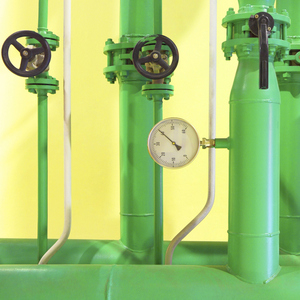LNG export on the verge of reality

PHOTO: US ENERGY SERVICES
October 28, 2015
BY Andy Huenefeld, U.S. Energy Services
As the U.S. natural gas market turns its eyes to 2016, there will be a new variable in the mix. After years of talking, financing, and construction, the first cargo of liquefied natural gas (LNG) is set to leave the U.S. Gulf Coast in the first quarter of the year. Cheniere Energy’s Louisiana-located Sabine Pass LNG terminal is slated to become the first of a number of pending projects to begin operation. The company had initially targeted late 2015 for commencement, but is now likely tracking toward an early-2016 start date.
Sabine Pass has full regulatory approval to export about 3.6 Bcf per day, but the approved capacity of the current construction project is 2.2 Bcf per day, with the remainder planned for future development. Initial volumes are expected to be about 0.5 Bcf per day and ramp up to 1.0 Bcf per day throughout the year. Although these numbers may seem small in a market that produces well over 70 Bcf per day, the exports will add to growing demand across multiple sectors and could make for a tighter domestic market.
LNG exports are one representation of the dramatic shift that has occurred in market sentiment over the past ten years. As recently as the middle of the last decade, conventional wisdom dictated that the U.S. was running out of domestic natural gas supply and production volumes were doomed to a perpetual state of decline. Based on this line of thinking capital was poured into building out LNG import capability on the Gulf Coast and East Coast with the idea that foreign supplies would soon be relied upon to meet growing domestic demand. Indeed, new construction projects brought import capacity to over 18 Bcf per day, or more than a quarter of U.S. demand in 2010. That capacity has been utilized at an average of less than 4 percent over the past five years, with imports more recently flat lining below 0.5 Bcf per day.
Now, with surging domestic output, the focus has firmly turned to exports. The same firms who rushed to build import capacity are now investing new capital into reversing pipeline flows and converting terminals to facilitate exports. Including Sabine Pass, there are five terminals currently under construction with a total of more than 8.5 Bcf per day of capacity, most of which is slated to come online between 2017 and 2019.
Advertisement
While near-term global dynamics have been altered unfavorably for the industry since most of the decisions to invest in LNG exports were made, most of the under-construction volume is already tied to firm long-term contracts. These contracted volumes will still likely be shipped out of a U.S. market which is expected to find itself as an overall net exporter of natural gas before the end of the decade, a prospect that would have sounded impossible in the not-too-distant past.
| Natural Gas Prices | Nymex | Ventura | SoCal Citygate | ||
| 8/31/2015 | $2.69 | $2.64 | $3.10 | ||
| 10/27/2015 | $2.40 | $2.37 | $2.92 | ||
| 10/28/2014 | $3.66 | $3.69 | $4.20 | ||
Advertisement
Related Stories
CARB on June 27 announced amendments to the state’s LCFS regulations will take effect beginning on July 1. The amended regulations were approved by the agency in November 2024, but implementation was delayed due to regulatory clarity issues.
Legislation introduced in the California Senate on June 23 aims to cap the price of Low Carbon Fuel Standard credits as part of a larger effort to overhaul the state’s fuel regulations and mitigate rising gas prices.
The government of Brazil on June 25 announced it will increase the mandatory blend of ethanol in gasoline from 27% to 30% and the mandatory blend of biodiesel in diesel from 14% to 15%, effective Aug. 1.
The U.S. EIA reduced its 2025 and 2026 production forecasts for a category of biofuels that includes SAF in its latest Short-Term Energy Outlook, released June 10. The forecast for 2025 renewable diesel production was also revised down.
The U.S. exported 21,545.9 metric tons of biodiesel and biodiesel blends of B30 and greater in April, according to data released by the USDA Foreign Agricultural Service on June 4. U.S. imports of biodiesel were at 4,417.3 metric tons for the month.
Upcoming Events









